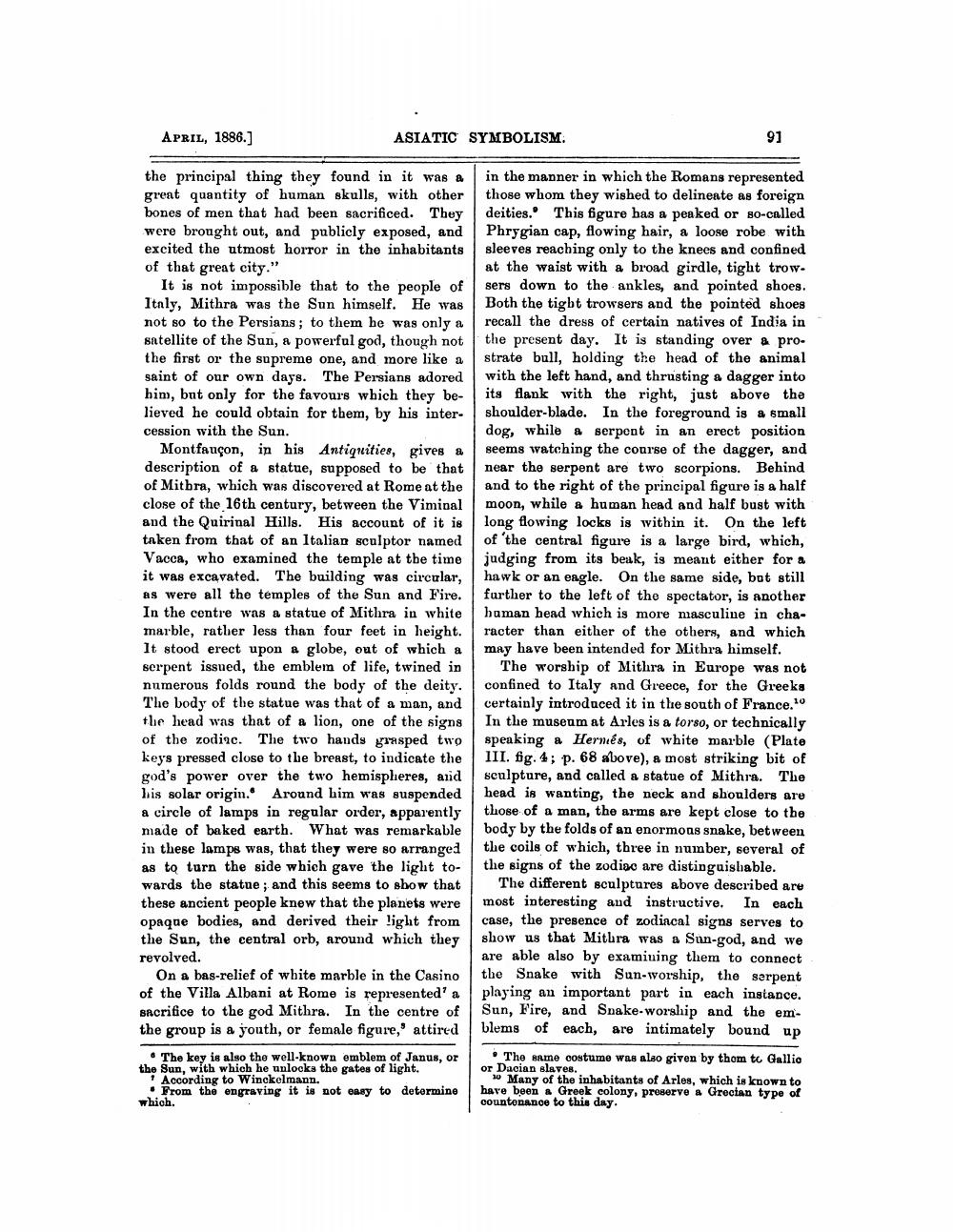________________
APRIL, 1886.)
ASIATIC SYMBOLISM.
the principal thing they found in it was a grent quantity of human skulls, with other bones of men that had been sacrificed. They were brought out, and publicly exposed, and excited the utmost horror in the inhabitants of that great city."
It is not impossible that to the people of Itnly, Mithra was the Sun himself. He was not so to the Persians; to them he was only a satellite of the Sun, a powerful god, though not the first or the supreme one, and more like a saint of our own days. The Persians adored him, but only for the favours which they believed he could obtain for them, by his intercession with the Sun.
Montfaucon, in his Antiquities, gives a description of a statue, supposed to be that of Mitbra, which was discovered at Rome at the close of the 16th century, between the Viminal and the Quirinal Hills. His account of it is taken from that of an Italian sculptor named Vacca, who examined the temple at the time it was excavated. The building was circular, as were all the temples of the Sun and Fire. In the centre was a statue of Mithra in white marble, rather less than four feet in height. It stood erect upon a globe, out of which a serpent issued, the emblem of life, twined in numerous folds round the body of the deity. The body of the statue was that of a man, and the head was that of a lion, one of the signs of the zodiac. The two hands grasped two keys pressed close to the breast, to indicate the god's power over the two hemispheres, and his solar origin. Around him was suspended a circle of lamps in regular order, apparently made of baked earth. What was remarkable in these lamps was, that they were so arranged
trn the side which gave the light to wards the statue ; and this seems to show that these ancient people knew that the planets were opaque bodies, and derived their light from the Sun, the central orb, around which they revolved.
On a bas-relief of white marble in the Casino of the Villa Albani at Rome is represented' a Bacrifice to the god Mithra. In the centre of the group is a youth, or female figure, attired
in the manner in which the Romans represented those whom they wished to delineate as foreign deities. This figure has a peaked or so-called Phrygian cap, flowing hair, a loose robe with sleeves reaching only to the knees and confined at the waist with a broad girdle, tight trowsers down to the ankles, and pointed shoes. Both the tigbt trowsers and the pointed shoes recall the dress of certain natives of India in the present day. It is standing over & prostrate bull, holding the head of the animal with the left hand, and thrusting a dagger into its flank with the right, just above the shoulder-blade. In the foreground is a small dog, while a serpent in an erect position seems watching the course of the dagger, and near the serpent are two scorpions. Behind and to the right of the principal figure is a half moon, while a human head and half bust with long flowing locks is within it. On the left of 'the central figure is a large bird, which, judging from its beak, is meant either for a hawk or an eagle. On the same side, but still further to the left of the spectator, is another haman head which is more masculine in character than either of the others, and which may have been intended for Mithra himself.
The worship of Mithra in Europe was not confined to Italy and Greece, for the Greeks certainly introduced it in the south of France.10 In the museum at Arles is a torso, or technically speaking a Hermés, of white marble (Plate III. fig. 4; p. 68 above), a most striking bit of sculpture, and called a statue of Mithra. The head is wanting, the neck and shoulders are those of a man, the arms are kept close to the body by the folds of an enormous snake, between the coils of which, three in number, several of the signs of the zodiso are distinguishable.
The different sculptures above described are most interesting and instructive. In each case, the presence of zodiacal signs serves to show us that Mithra was a Sun-god, and we are able also by examining them to connect the Snake with Sun-worship, the serpent playing an important part in each instance. Sun, Fire, and Snake-worship and the emblems of each, are intimately bound up
• The key is also the well-known emblem of Janus, or the Sun, with which he unlocks the gates of light. + According to Winckelmann.
From the engraving it is not easy to determine which.
The same costume was also given by them to Gallio or Dacian slaves.
w Many of the inhabitants of Arles, which is known to have been a Greek colony, preserve & Grecian type of countonance to this day.




